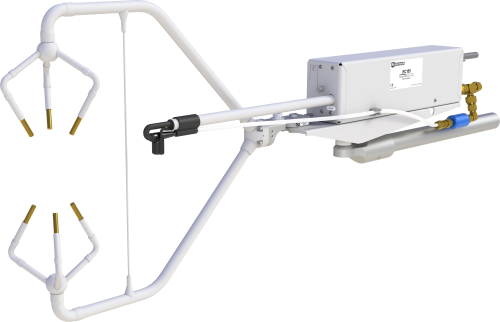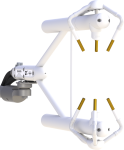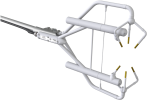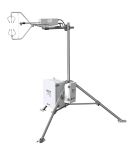
Use as part of closed-path eddy-covariance system






概要
Campbell Scientific's EC155 closed-path analyzer incorporates vortex technology for reduced maintenance, an absolute pressure sensor in the sample cell for more accurate measurements, and a sample cell with improved corrosion protection. The EC155 can be combined with the CSAT3A sonic anemometer, as shown in the main image. The revised CSAT3A has a more aerodynamic and rigid design.
The EC155 is ordered as part of a CPEC300-series system (CPEC300, CPEC306, or CPEC310), which also includes the sample pump, data logger, optional valve module, and optional scrub module to provide a zero air source. The EC155 with anemometer simultaneously measures absolute carbon dioxide and water vapor mixing ratio, sample cell temperature and pressure, and three-dimensional wind speed and sonic air temperature.
続きを読む利点と特徴
- Vortex Intake (U.S. Pat. No. 9,217,692) greatly reduces maintenance frequency compared to traditional in-line filters
- Heated inlet increases protection against condensation
- More accurate pressure measurements with the new sample cell absolute pressure sensor
- Fully integrated, detachable intake
- Improved corrosion protection with stainless-steel sample cell
- Improved sonic temperature from more rigid CSAT3 geometry
- Stream-lined, aerodynamic CSAT3A mounting
- Slim aerodynamic shape with minimal wind distortion
- Analyzer, sample cell, and sonic anemometer measurements have matched bandwidths and are synchronized by a common set of electronics
- Low power consumption; suitable for solar power applications
- Low noise
- Small sample cell for excellent frequency response
- Integrated zero/span connection for simplified field zero/span
- Field rugged
- Field serviceable
- Factory calibrated over wide range of CO2, H2O, pressure and temperature in all combinations encountered in practice
- Extensive set of diagnostic parameters
- Fully compatible with Campbell Scientific data loggers; field setup, configuration, and field zero and span can be accomplished directly from the data logger
- Rain: innovative signal processing and transducer wicks considerably improve performance of the anemometer during precipitation events
イメージ

詳細
The EC155 has the following outputs:
- Ux (m/s)*
- Uy (m/s)*
- Uz (m/s)*
- Sonic Temperature (°C)*
- Sonic Diagnostic*
- CO2 Mixing Ratio (µmol/mol)
- H2O Mixing Ratio (mmol/mol)
- Gas Analyzer Diagnostic
- Cell Temperature (°C)
- Cell Pressure (kPa)
- CO2 Signal Strength
- H2O Signal Strength
- Differential Pressure (kPa)
- Source Temperature (°C)
*Requires a CSAT3A Sonic Anemometer Head.
仕様
| Operating Temperature Range | -30° to +50°C |
| Operating Pressure | 70 to 106 kPa |
| Input Voltage Range | 10 to 16 Vdc |
| Power | 5 W (steady state and power up) at 25°C |
| Measurement Rate | 60 Hz |
| Output Bandwidth | 5, 10, 12.5, or 20 Hz (user-programmable) |
| Output Options | SDM, RS-485, USB, analog (CO2 and H2O only) |
| Auxiliary Inputs | Air temperature and pressure |
| EC100 Barometer Accuracy |
|
| Sample Intake/Sonic Volume Separation | 15.6 cm (6.1 in.) |
| Warranty | 3 years or 17,500 hours of operation (whichever comes first) |
| Cable Length | 3 m (10 ft) from EC155/CSAT3A to EC100 |
| Weight |
|
Gas Analyzer |
|
| Sample Cell Thermistor Accuracy | ± 0.15°C (-30° to +50°C) |
| Sample Cell Pressure Accuracy | ± 1.5 kPa (> 0°C ), increasing linearly to ±3.7 kPa at -30°C |
Gas Analyzer - CO2 Performance |
|
| Accuracy |
|
| Precision RMS (maximum) |
0.15 µmol/mol Nominal conditions for precision verification test: 25°C, 86 kPa, 400 μmol/mol CO2, 12°C dewpoint, and 20 Hz bandwidth. |
| Calibrated Range | 0 to 1,000 μmol/mol (0 to 3,000 µmol/mol available upon request.) |
| Zero Drift with Temperature (maximum) | ±0.3 μmol/mol/°C |
| Gain Drift with Temperature (maximum) | ±0.1% of reading/°C |
| Cross Sensitivity (maximum) | ±1.1 x 10-4 mol CO2 /mol H2O |
Gas Analyzer - H2O Performance |
|
| Accuracy |
|
| Precision RMS (maximum) |
0.006 mmol/mol Nominal conditions for precision verification test: 25°C, 86 kPa, 400 μmol/mol CO2, 12°C dewpoint, and 20 Hz bandwidth. |
| Calibrated Range | 0 to 72 mmol/mol (38°C dewpoint) |
| Zero Drift with Temperature (maximum) | ±0.05 mmol/mol/°C |
| Gain Drift with Temperature (maximum) | ±0.3% of reading/°C |
| Cross Sensitivity (maximum) | ±0.1 mol H2O/mol CO2 |
Sonic Anemometer - Accuracy |
|
| -NOTE- | The accuracy specification for the sonic anemometer is for wind speeds < 30 m s-1 and wind angles between ±170°. |
| Offset Error |
|
| Gain Error |
|
| Measurement Precision RMS |
|
ドキュメント
マニュアル
テクニカルペーパー
- Quantifying Frequency Response of a Low-power Closed-path CO2 and H2O Eddy-covariance System
- EC150, IRGASON, or EC155: Which CO2 and H2O Eddy-Covariance System Is Best for My Application?
- Damping Temperature Fluctuations in the EC155 Intake Tube
- Molecular Sieve CO2 and H2O Scrubbing Solution
- Replacing the Vortex Intake in an Older EC155
- An eddy-covariance system with an innovative vortex intake for measuring carbon dioxide and water fluxes of ecosystems
コンプライアンス
その他
- Performance Evaluation of an Innovative Sampling System for Closed Path Eddy Covariance Measurements
- Using Molecular Sieve to Zero Infrared Gas Analyzers for Eddy Covariance or Atmospheric Profile Measurements
- Field-Performance Verification of Carbon Dioxide, Water, and Nitrous Oxide Closed-Path Eddy Covariance Systems with Vortex Intakes Poster
ダウンロード
ECMon v.1.6 (10.7 MB) 29-03-2016
EC100-Series Support Software.
EC100 OS v.8.02 (560 KB) 14-10-2019
EC100 Operating System.
Watch the Video Tutorial: Updating the EC100 Operating System.
Device Configuration Utility v.2.33 (49.6 MB) 07-07-2025
A software utility used to download operating systems and set up Campbell Scientific hardware. Also will update PakBus Graph and the Network Planner if they have been installed previously by another Campbell Scientific software package.
Supported Operating Systems:
Windows 11 or 10 (Both 32 and 64 bit)
よくある質問
EC155に関するよくある質問の数: 8
すべて展開すべて折りたたむ
-
The EC155 requires a barometer for several reasons. First, the EC155 calculates CO2 as a concentration, and these values must be multiplied by the air density to get the CO2 flux. Second, the closed-path analyzer measures the number of CO2 molecules in the path and converts them to a concentration. This conversion requires a measure of sample cell pressure, which in older EC155 models (serial numbers less than 2000) is the sum of the barometer and differential sensor. In newer EC155 models (serial numbers 2000 or greater), this conversion still requires a measure of sample cell pressure, but it is done with an absolute pressure sensor in the sample cell. Finally, the EC155 has been calibrated at the factory over a range of barometric pressures.
-
Precipitation can block the infrared beam of an open-path IRGA—primarily through accumulation on the windows and by falling through the measurement path. The EC155 is a closed-path IRGA that is protected from rainfall by taking its measurements within a sample cell assembly. Older EC155 models (serial numbers less than 2000) have a heated intake assembly with a rain diverter to prevent precipitation from entering the sample cell. Newer EC155 models (serial numbers 2000 and greater) have a heated inlet and vortex intake (U.S. Pat. No. 9,217,692), which significantly improve performance during precipitation events and in conditions of high particulate concentrations, such as dust storms. However, measurements from sonic anemometers can also be affected by rainfall, especially if droplets accumulate on transducer faces. Therefore, it is important to continue monitoring data during rainfall events to ensure quality measurements are included in final calculations of flux.
-
For more information, see the white paper “EC150, IRGASON, or EC155: Which CO2 and H20 Eddy-Covariance System Is Best for My Application?”
-
Newer EC155 models (serial numbers 2000 and greater) take advantage of the new vortex intake technology (U.S. Pat. No. 9,217,692), which significantly reduces the frequency of maintenance required, especially in dustier, more polluted conditions. The new models also have an absolute pressure sensor instead of a differential one, which improves the pressure measurements. Finally, the new design uses a stainless-steel sample cell, which provides added protection against corrosion.
-
モレキュラーシーブは、どの国にも出荷できる非危険物です。
-
モレキュラーシーブは、古い過塩素酸マグネシウムボトルの直接の代替品です。モレキュラーシーブは、古いボトルを使用していたすべてのCampbell Scientifcのアナライザに使用できます。
-
モレキュラーシーブは、当社のエンジニアリング部門によって、空気サンプルから CO2 と H2O を除去するのに効果的であることが実証されています。変更が行われた理由は 2 つあります。
- それは以前の化学物質を使用するよりも安全な代替手段でした。
- 化学物質の輸送規制が強化されたため、サプライヤーの数が制限されました。
-
ドロップイン交換用のボトルには、ペレットと上部の膜が入っています。膜は、ガスがゼオライトを通過できるようにしながらペレットを封じ込めるために必要です。ボトルの設置面積は、古い過塩素酸マグネシウムのボトルと同じです。各ボトルの量はボトルに記載されています。各分析装置に必要なモレキュラーシーブの量は次のとおりです。
- EC150 には 22 g (ドロップインボトル) が必要です。
- IRGASON® には 22 g (ドロップインボトル) が必要です。
- EC155 には 22 g (ドロップインボトル) が必要です。
- AP200 には 500 g (詰め替え用) が必要です。
- 27423 には 1000 g (詰め替え用) が必要です。
- 31022 には 500 g (詰め替え用) が必要です。
ケーススタディ
森林生息地は、他のどの陸上バイオームよりも炭素循環とプロセスに貢献しています。地球の陸上に貯蔵されている炭素の半分以上が、森林生態系の幹、枝、葉、根、土壌に貯蔵されていると考えられています。炭素吸収源としての重要性を考えると、科学界では、さまざまな森林生息地、および同様の特性を持ちながらも樹齢が異なる森林における総炭素隔離を理解し、定量化することがますます急務となっています。 2001 年、学界、カナダ政府機関、民間部門のパートナーシップにより、ブリティッシュ コロンビア州バンクーバー島のアイランド ティンバーランドにある 13 年物のダグラスモミ林に高さ 20 メートル (65 フィート) のフラックス タワーが設置されました。この設置は、ダグラスモミの伐採サイクル生産性に関する長期的クロノシーケンス研究の一環です。ブリティッシュ コロンビア大学の科学者は、2001 年以来、渦相関 (EC)......続きを読む
Privacy Policy Update
We've updated our privacy policy. 詳細はこちら
Cookie Consent
Update your cookie preferences. クッキーの設定を更新する






